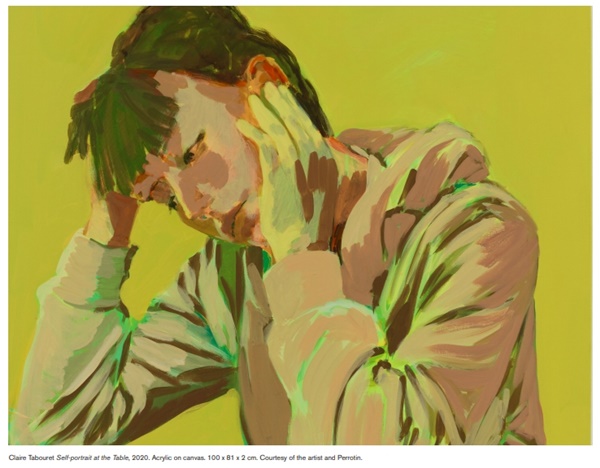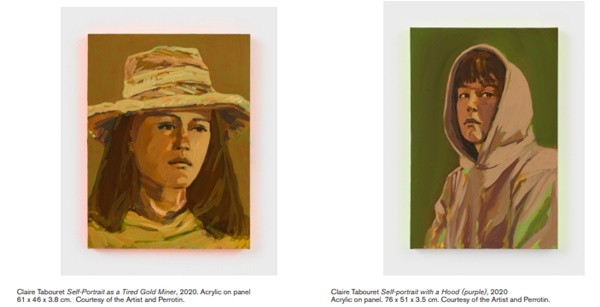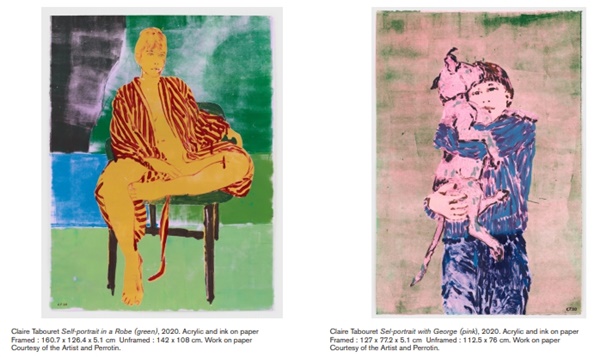"LOCKDOWN SELF-PORTRAITS"
Claire Tabouret

PERROTIN
TOKYO 1F, 6-6-9 ROPPONGI, MINATO-KU, TOKYO 106-0032TEL : +81 3 6721 0687 FAX : +81 3 6721 0687 e-mail:


November 19 > December 31, 2020



Perrotin Tokyo is pleased to announce a solo exhibition of new
paintings by Los Angeles-based French artist Claire Tabouret. On
view is a new series of intimate portraits of herself, created during the
lockdown.
For her first solo show in Tokyo, the artist has shifted her gaze inward with a new body of work titled “Lockdown Self-portraits”. Tabouret often focuses on the relationship between two or more figures in her work, but the lack of gatherings in today’s world has altered her focus to the dynamics between herself and the viewer. Self-portraiture has been a significant part of the artist’s practice for nearly a decade, but the involuntary isolation of our current reality compelled Tabouret to use herself as a subject out of necessity. Pointing to the influence of Helene Schjerfbeck’s very intimate self-portraits which were often made when no other models were available in the secluded Finnish countryside where she lived, Tabouret reflects that, “it was in this very natural way that I began painting myself, because the urgency to paint is always there, no matter what.”
Elements such as makeup and costumes frequently serve as a kind of armor for the figures in Tabouret’s works- masking certain parts of them from the viewer and allowing them to exhibit a feeling of selfassurance. In these new self-portraits, the sense of fearlessness is diminished if not entirely absent, and the shields in place are more subtle but still present: an oversized robe, a hooded sweatshirt, her dog George placed decisively between herself and the viewer. Vuillard’s masterful interiors are evoked, whose figures are nearly engulfed by the fabrics and patterns in the room. The same feeling is present in Tabouret’s new works; a sense of heaviness but also of the warmth and protection offered by these domestic settings. A thick, striped bathrobe serves as an allusion to Matisse’s Odalisque paintings, while the hooded self- portraits refer back to Zurbarán’s paintings of monks and Gaëtan Gatien de Clérambault’s thousands of photographs of veiled women. These coverings act as a type of refuge, almost like a womb, and represent the temptation of the artist to disappear. In Self-portrait at the Table, the artist’s hands partly obscure her face while her eyes look away, avoiding the viewer. Channeling Manet’s La Prune, Tabouret recalls wanting “to find this special gaze that is looking inward.”
Alongside these paintings Tabouret also presents a series of new monoprints. These works are all unique as their name indicates, but the nature of the process is such that each new image contains a ghost of the previous one. Every work is a reaction to the last, and this repetition of motif creates a musical rhythm throughout the exhibition, which Tabouret likens to improvisation in jazz. These serial selfportraits model the compositions of the paintings while retaining their singular deviations. Collectively, the paintings and monoprints compel the viewer to question their own memory of what they’ve already seen.
Despite Tabouret being the only subject in the works, it quickly becomes evident that she is withdrawing from the viewer, perhaps only an instant away from vanishing entirely. The figure’s visage is the same but not uniform, marking the passage of time and honoring the fleeting nature of the human face. These works convey a sense of temporality, as if they might change at any moment, echoing the uncertainties of the time during which they were made. As Tabouret remarks, “there’s something very uneasy about being right now and it is reflected in these works.”
Claire Tabouret was born in 1981 in Pertuis, France. She received her B.A. from the École des Beaux-Arts in Paris and also studied at Cooper Union in New York City in 2005. She currently lives and works in Los Angeles.
The artist’s most recent solo exhibition, “Mirrors and Reflections” is on view at Jordan Schnitzer Museum of Art, Eugene, Oregon, USA through January 10 2021, and also shows “La Ronde” at Musèe des Beaux Arts de Rouen, France;
Recent group shows include CaixaForum, Barcelona (through January 21, 2021); Zuzeum Art Centre, Riga, Latvia; Arsenal Contemporary Art, Montreal; and, CaixaForum, Madrid. Her work has been the subject of numerous exhibitions with museums including Collection Lambert, Avignon, France; Villa Medici, Rome; Yuz Museum, Shanghai; Palazzo Fruscione, Salerno, Italy; The Drawing Center, New York; Hangar à Bananes, Nantes, France; Palazzo Grassi, Venice; Maison Guerlain, Paris; and, Galerie du Jour Agnès b, Paris.
Her works are in major collections including those of LACMA (Los Angeles County Museum of Art); Musée des Beaux Arts de Montreal; Arsenal Contemporary Art, Montreal; Pérez Art Museum, Miami; Pinault Collection; Yuz Museum, Shanghai; FRAC Auvergne, France, FRAC Haute-Normandie, France; Agnès b Collection; Foundation Colas, Paris; Collection Emerige, Paris; Leuwen Foundation, Belgium; Zuzāns Collection, Riga, Latvia; and, Fondazione Fausto Melotti, Milan.
For her first solo show in Tokyo, the artist has shifted her gaze inward with a new body of work titled “Lockdown Self-portraits”. Tabouret often focuses on the relationship between two or more figures in her work, but the lack of gatherings in today’s world has altered her focus to the dynamics between herself and the viewer. Self-portraiture has been a significant part of the artist’s practice for nearly a decade, but the involuntary isolation of our current reality compelled Tabouret to use herself as a subject out of necessity. Pointing to the influence of Helene Schjerfbeck’s very intimate self-portraits which were often made when no other models were available in the secluded Finnish countryside where she lived, Tabouret reflects that, “it was in this very natural way that I began painting myself, because the urgency to paint is always there, no matter what.”
Elements such as makeup and costumes frequently serve as a kind of armor for the figures in Tabouret’s works- masking certain parts of them from the viewer and allowing them to exhibit a feeling of selfassurance. In these new self-portraits, the sense of fearlessness is diminished if not entirely absent, and the shields in place are more subtle but still present: an oversized robe, a hooded sweatshirt, her dog George placed decisively between herself and the viewer. Vuillard’s masterful interiors are evoked, whose figures are nearly engulfed by the fabrics and patterns in the room. The same feeling is present in Tabouret’s new works; a sense of heaviness but also of the warmth and protection offered by these domestic settings. A thick, striped bathrobe serves as an allusion to Matisse’s Odalisque paintings, while the hooded self- portraits refer back to Zurbarán’s paintings of monks and Gaëtan Gatien de Clérambault’s thousands of photographs of veiled women. These coverings act as a type of refuge, almost like a womb, and represent the temptation of the artist to disappear. In Self-portrait at the Table, the artist’s hands partly obscure her face while her eyes look away, avoiding the viewer. Channeling Manet’s La Prune, Tabouret recalls wanting “to find this special gaze that is looking inward.”
Alongside these paintings Tabouret also presents a series of new monoprints. These works are all unique as their name indicates, but the nature of the process is such that each new image contains a ghost of the previous one. Every work is a reaction to the last, and this repetition of motif creates a musical rhythm throughout the exhibition, which Tabouret likens to improvisation in jazz. These serial selfportraits model the compositions of the paintings while retaining their singular deviations. Collectively, the paintings and monoprints compel the viewer to question their own memory of what they’ve already seen.
Despite Tabouret being the only subject in the works, it quickly becomes evident that she is withdrawing from the viewer, perhaps only an instant away from vanishing entirely. The figure’s visage is the same but not uniform, marking the passage of time and honoring the fleeting nature of the human face. These works convey a sense of temporality, as if they might change at any moment, echoing the uncertainties of the time during which they were made. As Tabouret remarks, “there’s something very uneasy about being right now and it is reflected in these works.”
Claire Tabouret was born in 1981 in Pertuis, France. She received her B.A. from the École des Beaux-Arts in Paris and also studied at Cooper Union in New York City in 2005. She currently lives and works in Los Angeles.
The artist’s most recent solo exhibition, “Mirrors and Reflections” is on view at Jordan Schnitzer Museum of Art, Eugene, Oregon, USA through January 10 2021, and also shows “La Ronde” at Musèe des Beaux Arts de Rouen, France;
Recent group shows include CaixaForum, Barcelona (through January 21, 2021); Zuzeum Art Centre, Riga, Latvia; Arsenal Contemporary Art, Montreal; and, CaixaForum, Madrid. Her work has been the subject of numerous exhibitions with museums including Collection Lambert, Avignon, France; Villa Medici, Rome; Yuz Museum, Shanghai; Palazzo Fruscione, Salerno, Italy; The Drawing Center, New York; Hangar à Bananes, Nantes, France; Palazzo Grassi, Venice; Maison Guerlain, Paris; and, Galerie du Jour Agnès b, Paris.
Her works are in major collections including those of LACMA (Los Angeles County Museum of Art); Musée des Beaux Arts de Montreal; Arsenal Contemporary Art, Montreal; Pérez Art Museum, Miami; Pinault Collection; Yuz Museum, Shanghai; FRAC Auvergne, France, FRAC Haute-Normandie, France; Agnès b Collection; Foundation Colas, Paris; Collection Emerige, Paris; Leuwen Foundation, Belgium; Zuzāns Collection, Riga, Latvia; and, Fondazione Fausto Melotti, Milan.
 |
Claire Tabouret |
mpefm
JAPAN art press release
Opening Hours:
Tue - Sat noon - 6pm by appointment only

Opening Hours:
Tue - Sat noon - 6pm by appointment only
QR of this press release
in your phone, tablet








